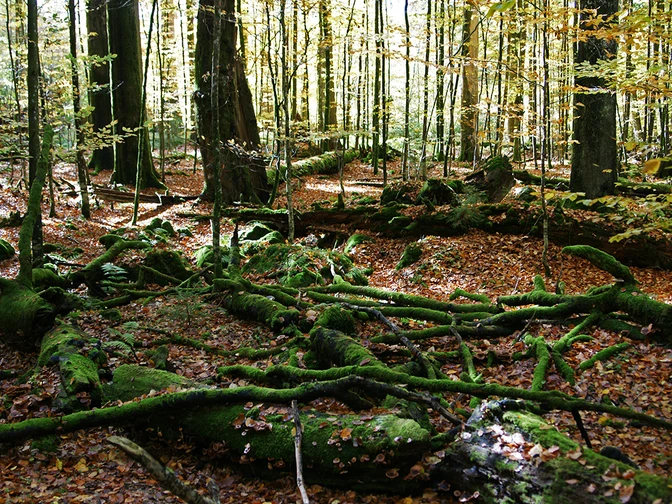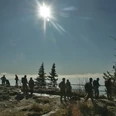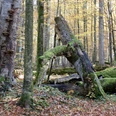- 4:30 h
- 11.80 km
- 290 m
- 290 m
- Start: Parking area Brechhäuslau, Zwieslerwaldhaus, 94227 Lindberg
Advice:
Easy tour, but one longer, moderately steep ascent.
Refreshment point at Zwieslerwaldhaus, Bayerisch Eisenstein and Schwellhäusl (Please inform about the opening hours).
Local public transport network:
Igelbus stop Zwieslerwaldhaus, Brechhäuslau
(Falkenstein-Bus, line 7150)
For timetables see: www.bayerwald-ticket.com
Navigation:
Zwieslerwaldhaus, 94227 Lindberg
Parking area Brechhäuslau, GPS 49.096588, 13.237619
Tip: The tour can also start and end at the German-Czech border station at Bayerisch Eisenstein.
Stages:
Zwieslerwaldhaus - Hans-Watzlik-Hain - Schmalzbach-Schwelle/Schwellhäusl - Bayerisch Eisenstein - Zwieslerwaldhaus
Tour description:
From the Igelbus stop Brechhäuslau or the parking area in Zwieslerwaldhaus (690 meters above sea level), we follow the signpost 'Schwarzstorch' to the west towards Schwellhäusl. We cross the Deffernik in a fold and reach a crossroads. After choosing the circular rout ‘Schwarzstorch’ on the right, the rout leads us along a wide gravel road. After a few hundred meters, we reach the native forest area of Hans-Watzlik-Hain. The peculiarities of this relic are explained on an information panel. From the Große Tanne, a narrow path leads parallel to the forest path through the impressive area (Caution: there is no signpost here. In case of snow: only use it, when the rangers have already set up a snowshoe trail!). When this trail meets the wide gravel road again, we keep left and continue our hike to Schwellhäusl. The excursion rest place is located idyllically next to the Schmalzbach-Schwelle (745 meters above sea level), a reservoir originally built for timber drift. We can also see trees gnawed by beavers here near the shore.
At the Schmalzbach-Schwelle, we keep right and follow the sign 'Bussard' towards Bayerisch Eisenstein. We have to face the only longer climb of this tour now. Later, we cross a gravel road. At the next crossroads, we keep left until we meet a gravel road again. We follow it for a short distance to the right and reach the shelter of Hochbergsattel, the highest point of today's tour (847 meters above sea level).
The 'Bussard' points right into the forest now. We follow it, cross another gravel road and finally arrive at a crossroads. Here we turn right to Bayerisch Eisenstein (720 meters above sea level). Once in the village, we continue with the 'Bussard' to the left at first, past the Wanderpark, and then follow the main road for a short time. The trail branches off to the left quite soon and we leave this place on a forestal road.
After 200 meters, we turn left again with the 'Bussard'. Now we are back in the national park. The path ascends gently up to a gravel road. We follow it to the right for 1 kilometer until the 'Bussard' leaves it again to the left. The forest path leads us along a slope towards Eisernes Kreuz (790 meters above sea level). Going past the refuge, the 'Bussard' finally leads us back to Schmalzbach-Schwelle. At the refreshment point, we change our signpost and choose the second part of the circular trail 'Schwarzstorch' to the right towards Schwellsteig. The river channel on our left once served to supply water from the Deffernik to Schmalzbach-Schwelle, in order to enable an efficient timber drift. Back at the fork, that we already know, we cross the Deffernik once again and finally reach the start point on the sign ‘Schwarzstorch’.
Correct on the go – all the time
- Always ensure to have good equipment: card, sturdy shoes, something to drink, first aid kit, bad weather clothing.
- Beware of falling trees and deadwood! The use of the path is at your own risk. In case of strong wind, please leave the forest for safety reasons.
- Path regulations in order to protect endangered plants and animals in certain areas of the national park
Did you know it?
The black stork (Ciconia nigra) is rarely found in Germany, in contrast to its larger relative, the white stork. As a habitat, it prefers near-natural deciduous forests with wetlands and water areas. It hunts small fishes and other water inhabitants. It is very sensitive and tends to leave its brood in case of disturbances. Therefore, not only the animals themselves, but also the nesting sites are under strict protection order. The bird lives in Africa during the winter months.
Back in 1950, the native forest area Hans-Watzlik-Hain has already been designated as a protected area. Among its woods are very old firs, beech and spruce trees. With a height of more than 52 meters, the Große Tanne at the beginning of the short adventure trail (path regulation!) is the largest tree within the entire national park. The area has been named after Hans Watzlik, a German-Bohemian writer.
Schwelle or Klause are artificial reservoirs that were built especially in the 19th century for timber drift. With their water, the tree trunks thrown into the mountain streams could be washed out of the forest. The streams below the Schwellen were often straightened and attached. Some of them are now under protection order.
Good to know
Best to visit
Tour information
Familiy-Friendly
Loop Road
Loop Road
Nature Highlight
Stop at an Inn
Contact person
Author
Nationalparkverwaltung Bayerischer Wald
Organization
Nationalparkverwaltung Bayerischer Wald
License (master data)
Nearby



